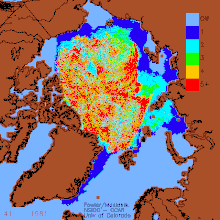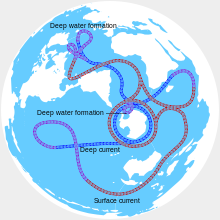
Back Аҩадатәи аокеан ҵааршә AB Laôt Arktik ACE Щтыгъэ Океан ADY Arktiese Oseaan AF Arktischer Ozean ALS አርክቲክ ውቅያኖስ AM Oceano Glacial Arctico AN Īshæf ANG उत्तरध्रुवीय महासागर ANP المحيط المتجمد الشمالي Arabic

| Earth's ocean |
|---|
|
Main five oceans division: Further subdivision: Marginal seas |
The Arctic Ocean is the smallest and shallowest of the world's five major oceans.[1] It spans an area of approximately 14,060,000 km2 (5,430,000 sq mi) and is known as one of the coldest of oceans. The International Hydrographic Organization (IHO) recognizes it as an ocean, although some oceanographers call it the Arctic Mediterranean Sea.[2] It has also been described as an estuary of the Atlantic Ocean.[3][4] It is also seen as the northernmost part of the all-encompassing World Ocean.
The Arctic Ocean includes the North Pole region in the middle of the Northern Hemisphere and extends south to about 60°N. The Arctic Ocean is surrounded by Eurasia and North America, and the borders follow topographic features: the Bering Strait on the Pacific side and the Greenland Scotland Ridge on the Atlantic side. It is mostly covered by sea ice throughout the year and almost completely in winter. The Arctic Ocean's surface temperature and salinity vary seasonally as the ice cover melts and freezes;[5] its salinity is the lowest on average of the five major oceans, due to low evaporation, heavy fresh water inflow from rivers and streams, and limited connection and outflow to surrounding oceanic waters with higher salinities. The summer shrinking of the ice has been quoted at 50%.[1] The US National Snow and Ice Data Center (NSIDC) uses satellite data to provide a daily record of Arctic sea ice cover and the rate of melting compared to an average period and specific past years, showing a continuous decline in sea ice extent.[6] In September 2012, the Arctic ice extent reached a new record minimum. Compared to the average extent (1979–2000), the sea ice had diminished by 49%.[7]

- ^ a b Pidwirny, Michael (2006). "Introduction to the Oceans". physicalgeography.net. Archived from the original on 9 December 2006. Retrieved 7 December 2006.
- ^ General oceanography : an introduction (2nd ed.). New York: Wiley. 1980. p. 501. ISBN 0471021024. OCLC 6200221.
- ^ Tomczak, Matthias; Godfrey, J. Stuart (2003). Regional Oceanography: an Introduction (2nd ed.). Delhi: Daya Publishing House. ISBN 978-81-7035-306-5. Archived from the original on 30 June 2007. Retrieved 22 April 2006.
- ^ "'Arctic Ocean' – Encyclopædia Britannica". Encyclopedia Britannica. Retrieved 2 July 2012.
As an approximation, the Arctic Ocean may be regarded as an estuary of the Atlantic Ocean.
- ^ Some Thoughts on the Freezing and Melting of Sea Ice and Their Effects on the Ocean Archived 8 November 2017 at the Wayback Machine K. Aagaard and R. A. Woodgate, Polar Science Center, Applied Physics Laboratory University of Washington, January 2001. Retrieved 7 December 2006.
- ^ "Arctic Sea Ice News and Analysis | Sea ice data updated daily with one-day lag". Retrieved 1 September 2020.
- ^ "Understanding the Arctic sea ice: Polar Portal". polarportal.dk. Retrieved 1 September 2020.


